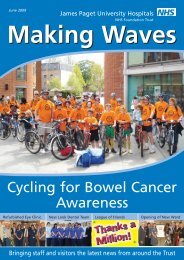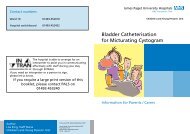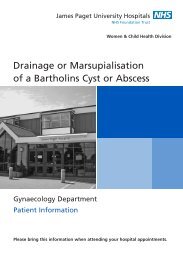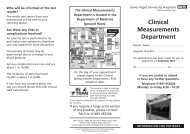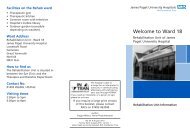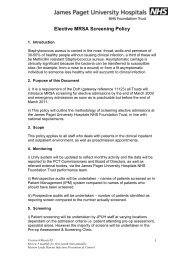Pelvic Floor Exercise Men leaflet - James Paget University Hospitals
Pelvic Floor Exercise Men leaflet - James Paget University Hospitals
Pelvic Floor Exercise Men leaflet - James Paget University Hospitals
Create successful ePaper yourself
Turn your PDF publications into a flip-book with our unique Google optimized e-Paper software.
<strong>James</strong> <strong>Paget</strong> <strong>University</strong> <strong>Hospitals</strong><br />
NHS Foundation Trust<br />
Physiotherapy Department<br />
<strong>Pelvic</strong> <strong>Floor</strong> Muscle<br />
<strong>Exercise</strong>s for <strong>Men</strong><br />
Telephone:<br />
01493 452378<br />
Patient Information
The exercises and advice in this <strong>leaflet</strong> will<br />
help you to improve your pelvic floor.<br />
It should be used to remind you of the<br />
programme your physiotherapist has already<br />
taught you. It should never be used unless<br />
you have been assessed by a specialist<br />
physiotherapist.<br />
<strong>Pelvic</strong> <strong>Floor</strong> Muscle <strong>Exercise</strong>s for <strong>Men</strong><br />
<strong>Pelvic</strong> floor muscle exercises help to strengthen<br />
the muscles which control your urine flow. They<br />
help you to stop leaking with activities like lifting,<br />
walking or getting out of a chair. They also help<br />
to improve the control of urine after a prostate<br />
operation or to stop after-dribble when you go to<br />
the toilet.<br />
The exercise can be described as tightening and<br />
lifting the muscles inside as if you are trying to stop<br />
the flow of urine.<br />
If you do them correctly you will see the base of<br />
the penis dip (pull back) and the testicles lift up.
<strong>Exercise</strong>s should be practised every day and include<br />
a mixture of slow and fast squeezes.<br />
Slow squeezes with maximum effort help to<br />
increase the muscle strength. Try to hold for as<br />
many seconds as possible but try not to squeeze<br />
the buttocks or thigh muscles. The quality of the<br />
squeeze is more important than the quantity, so<br />
aim for a few good squeezes.<br />
Fast squeezes help to prevent leakage of urine<br />
on activity. You should try to squeeze before any<br />
activity which causes leakage.<br />
Also try to do some ‘in-between’ exercises – tighten<br />
the muscles at 50% of your maximum squeeze and<br />
hold the squeeze whilst walking. This encourages<br />
the muscles to work with activity.<br />
After you have been to the toilet tighten your<br />
pelvic floor muscles as strongly as possible. This may<br />
help to ‘squeeze out’ the last few drops and avoid<br />
the after-dribble.<br />
Your physiotherapist is:
Author:<br />
Teresa Cook<br />
Physiotherapy Department<br />
Telephone: 01493 452378<br />
The hospital is able to arrange for an<br />
interpreter to assist you in communicating<br />
effectively with staff during your stay<br />
through INTRAN.<br />
If you need an interpreter or a person to sign,<br />
please let us know.<br />
If you require a large print version of this<br />
booklet, please contact PALS on<br />
01493 453240<br />
© February 2009<br />
<strong>James</strong> <strong>Paget</strong> <strong>University</strong> <strong>Hospitals</strong> NHS<br />
Foundation Trust<br />
Review Date: February 2012<br />
PH 16




